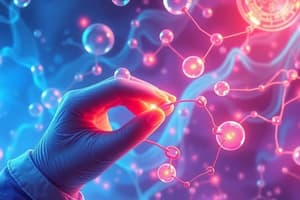Podcast
Questions and Answers
Define pharmacokinetics.
Define pharmacokinetics.
The study of absorption, distribution, metabolism (biotransformation), and excretion of drugs.
What is pharmacology?
What is pharmacology?
The science that deals with drugs regarding classification, pharmacokinetics, pharmacodynamics, side effects, and therapeutic uses.
What is pharmacodynamics?
What is pharmacodynamics?
The study of pharmacological and physiological effects of drugs and their mechanism of action.
What does pharmacogenomics study?
What does pharmacogenomics study?
Which of the following are branches of pharmacology? (Select all that apply)
Which of the following are branches of pharmacology? (Select all that apply)
What are the four pathways that control drug action?
What are the four pathways that control drug action?
The time it takes for a drug's effects to become noticeable after administration is called the ______.
The time it takes for a drug's effects to become noticeable after administration is called the ______.
Which routes of drug administration are considered enteral? (Select all that apply)
Which routes of drug administration are considered enteral? (Select all that apply)
What happens during first-pass metabolism?
What happens during first-pass metabolism?
List one advantage of the sublingual drug administration route.
List one advantage of the sublingual drug administration route.
Rectal administration bypasses the first-pass effect completely.
Rectal administration bypasses the first-pass effect completely.
Flashcards are hidden until you start studying
Study Notes
Pharmacology
- Science that studies drugs, their classification, pharmacokinetics, pharmacodynamics, side effects, and therapeutic uses.
- A drug is a substance used for prevention, diagnosis, treatment, and cure of diseases.
Pharmacokinetics
- Studies how the body handles a drug (absorption, distribution, metabolism, excretion).
Pharmacodynamics
- Studies the pharmacological & physiological effects of drugs and their mechanism of action.
Pharmacogenomics
- Study of individual differences in drug responses due to genetic variations.
Branches of Pharmacology
- Medical Pharmacology: Studies chemicals administered to achieve a beneficial therapeutic effect or for their toxic effects on parasites infecting the patient.
- Toxicology: Studies the harmful effects of chemicals on living systems.
Pharmacokinetics of Drugs
- Studies the movement of a drug over time through the body.
- The plasma concentration of drugs influences the drug's action.
- Clinicians need to understand the speed of onset, intensity, and duration of drug action, which are influenced by ADME:
- Absorption: How the drug enters the bloodstream from the site of administration.
- Distribution: How the drug moves from the bloodstream to tissues and organs.
- Metabolism: How the drug is chemically transformed, mainly in the liver.
- Excretion: The elimination of the drug and its metabolites from the body, primarily through urine and feces.
Onset of action
- The time it takes for a drug's effects to become noticeable.
- Typically ranges from 20 minutes to over an hour, depending on the drug and route.
Peak time
- The time at which the body displays the maximum plasma concentration of the drug.
Routes of drug administration
- Enteral: Drugs are administered through the gastrointestinal tract.
- Oral: Swallowing the drug.
- Sublingual: Placing the drug under the tongue.
- Rectal: Administering the drug through the rectum.
- Parenteral: Drugs are administered through injection.
- IV (intravascular): Directly into a vein.
- SC (subcutaneous): Into the subcutaneous tissue, usually the upper arm or abdomen.
- IM (intramuscular): Into a muscle.
Factors influencing route of administration
- Drug properties: Water or lipid solubility, ionization.
- Therapeutic objectives: Rapid onset of action, long-term administration, or localization to a specific site.
Enteral Routes
- Oral: Drugs are absorbed primarily from the duodenum, but some are absorbed from the stomach.
- Sublingual: Rapid absorption into the bloodstream, bypassing the stomach and intestines.
- Advantages:
- Rapid onset of action.
- Bypasses first-pass metabolism, leading to higher bioavailability.
- Excess drug can be easily removed from the mouth in emergencies.
- Advantages:
- Rectal: Used when oral route is unavailable, useful for patients who vomit or are unconscious.
- Advantages:
- Bypasses first-pass metabolism by a certain extent (50%).
- Suitable for children.
- Advantages:
Studying That Suits You
Use AI to generate personalized quizzes and flashcards to suit your learning preferences.



